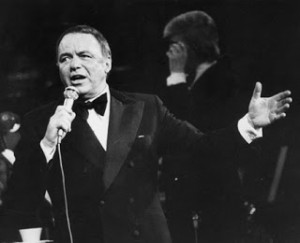I was recently interviewed for an upcoming HBO documentary about Frank Sinatra, during which I had occasion to recall the moment that I first started taking Sinatra seriously. It happened in 1973, when he resumed performing in public after an abortive “retirement” two years earlier. Among his first appearances was an NBC special called Ol’ Blue Eyes Is Back. My family watched it, of course, because my father was a Sinatra fan of long standing, but I wasn’t expecting any miracles. I was, after all, a high-school senior who’d never been able to see what my father saw in Ol’ Blue Eyes. To me he was yesterday’s news, a self-important man in a toupee who recorded stiff-as-a-board cover versions of songs like “Bad, Bad Leroy Brown” and “Sweet Caroline” and pretended to be hip. What could he possibly have had to say to me?
 The answer came when Sinatra sang “Send in the Clowns,” the show’s next-to-last number. Not only had I never before heard that now-standard ballad, but I didn’t even know who Stephen Sondheim was, being a small-town boy who lived far from Broadway. Yet I was stunned by the seriousness of both the song and Sinatra’s performance, which seemed to come from another world infinitely far removed from the ring-a-ding-ding midlife-crisis antics that I’d found so offputting. “You know, there really must be something to this guy,” I told myself, and resolved on the spot to dig deeper into his music.
The answer came when Sinatra sang “Send in the Clowns,” the show’s next-to-last number. Not only had I never before heard that now-standard ballad, but I didn’t even know who Stephen Sondheim was, being a small-town boy who lived far from Broadway. Yet I was stunned by the seriousness of both the song and Sinatra’s performance, which seemed to come from another world infinitely far removed from the ring-a-ding-ding midlife-crisis antics that I’d found so offputting. “You know, there really must be something to this guy,” I told myself, and resolved on the spot to dig deeper into his music.
I still have a clear mental picture of that performance. I remember how Sinatra walked to the lip of the stage, sat on the steps as the lights went down, said a few brief words about Sondheim and A Little Night Music, then started singing. But when I described the scene for HBO, I immediately added that I’d only seen Ol’ Blue Eyes Is Back once, when it aired in 1973, and that it was more than possible that my middle-aged memory was misleading me.
As soon as I got home, I went straight to YouTube and started searching, and mere minutes later I was watching a clip of Sinatra singing “Send in the Clowns” on NBC forty-one years ago. Sure enough, it was just as I recalled it: Sinatra sits on the steps, lit only by a tight pinspot, and sings the song with total involvement and unaffected simplicity, his face a grave and reverend mask of remembered sorrow.
How extraordinary that those four life-changing minutes should have etched themselves so precisely on my memory. That’s what great art can do to a susceptible boy.
